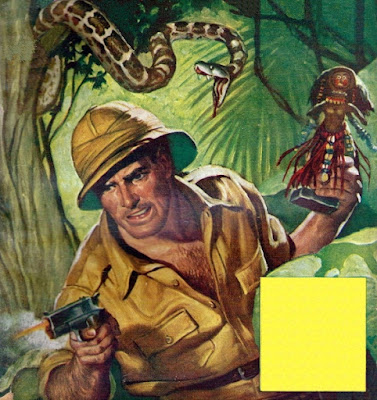Art by Rafael DeSoto
One of the enjoyable aspects of role-playing games is watching your character develop through continued play. Experience points are often the means through which such development is represented in game terms. The Adventures of Indiana Jones Role-Playing Game (hereinafter Adventures) does not have an experience point system; characters are essentially static. Adventures, however, does have rules for earning Player Points. Such points – like the name suggests – are assigned to the player and not the character. Since players can “trade off” the characters they play, it is appropriate for 'points' to be player-centric. Player Points are also earned by the Referee. They are generally obtained in two ways: meeting objectives and receiving awards.
Each 'episode' in an adventure lists objectives for the player characters and for the non-player characters. Players are not informed as to what the objectives are. Point values for the objectives are also listed. As an example, here are the objectives for the second episode in the Raiders of the Lost Ark Adventure Pack. (This is the episode that includes the scene in Nepal.)
PC (PLAYER) OBJECTIVESEach player receives the same number of 'objective' Player Points per episode. Evaluation of the player as an individual happens with 'award' Player Points. When 'award' Player Points are determined, three questions are asked of of each player by the Referee. “Then the players, as a group,” according to page 43, “apply the same questions to the Referee.” The questions are:
Re-establish the relationship between Indy and Marion (worth 1 Player Point).
Escape the Nazis who attack the PCs in The Raven (worth 2 Player Points).
Keep the headpiece to the Staff of Ra out of the Nazis' hands (worth 2 Player Points).
NPC (REFEREE) OBJECTIVES
Bring Indy and Marion together (worth 1 Player Point).
Bring the Nazis into The Raven (worth 1 Player Point).
Have both the PCs and NPCs gain a copy to the Staff of Ra (worth 2 Player Points).
For each question to which the answer is “yes,” the player (or Referee) receives one Player Point. These questions clearly establish the goals of the game: fun, role-playing, and imagination. This concept of 'award' Player Points is important for two reasons. First, for beginning players, it can be beneficial to have the purpose of Adventures (or any role-playing game) stated so succinctly. Second, distribution of 'award' Player Points represents a feedback mechanism. In other RPGs, feedback from a gamemaster to his or her players is common enough, but Adventures facilitates feedback from players to the Referee.
- Did the person make the game fun to play?
- Did the person play the part of his player character (or his NPCs) well?
- Did the person have good ideas?
'Objective' Player Points are determined and distributed at the end of an adventure; specifically, “When the adventure is over, the Referee should decide which objectives the player characters met, and which objectives his NPCs met.” Unfortunately, the rules are unclear as to when 'award' Player Points are provided. According to the rules, “The players and Referee also award Player Points to each other at the end of an adventure (or episode).” Which is it, adventure or episode? Given that the average number of episodes per adventure is six, whether Player Point awards are provided per adventure or per episode makes a significant difference in the potential amount of Player Points that the players and Referee may have. The rules state that “the Referee should try to keep from awarding more than 5 Player Points to each player in an adventure or episode.” Players can accumulate up to five 'objective' Player Points as a result of what happens in an episode. If we assume that 'award' Player Points are also determined per episode, players could be prevented from gaining 'award' Player Points due to the five point limit. Since this is contrary to the point of having 'award' Player Points, then those points should be determined per adventure. However, as we shall see below, this is also problematic.
“Player Points are a good measure of how well you play the game,” say the rules, “but they do serve one other, very special purpose.” Player Points can be spent to reduce damage effects by one level – “making a Serious wound a Medium wound, for example.” This costs five Player Points which must be spent at the time the damage is inflicted.
“You can accumulate Player Points from adventure to adventure,” the rules also state, “but you can't have more than 15 Player Points at any one time.” To emphasize the point, “If you earn Player Points that would put you over your limit, you lose the extra points.” If the episodic 'objective' Player Points and the 'award' Player Points are calculated at only at the end of an adventure, it's quite possible for more than fifteen points to accumulate for any given player. I would suggest that 'objective' Player Points be dispensed at the conclusion of each episode. This would allow players, and the Referee, to use those points during the adventure in which they are earned. This would also reduce the possibility of exceeding the fifteen point limit if all points are calculated at the end of an adventure.
Also, “If a player sacrifices his character's life to save another character (PC or NPC), he automatically earns 15 Player Points to use for his next character.” Presumably, this means “earns up to 15 Player Points,” since a player may not have more than fifteen points at any given time.




